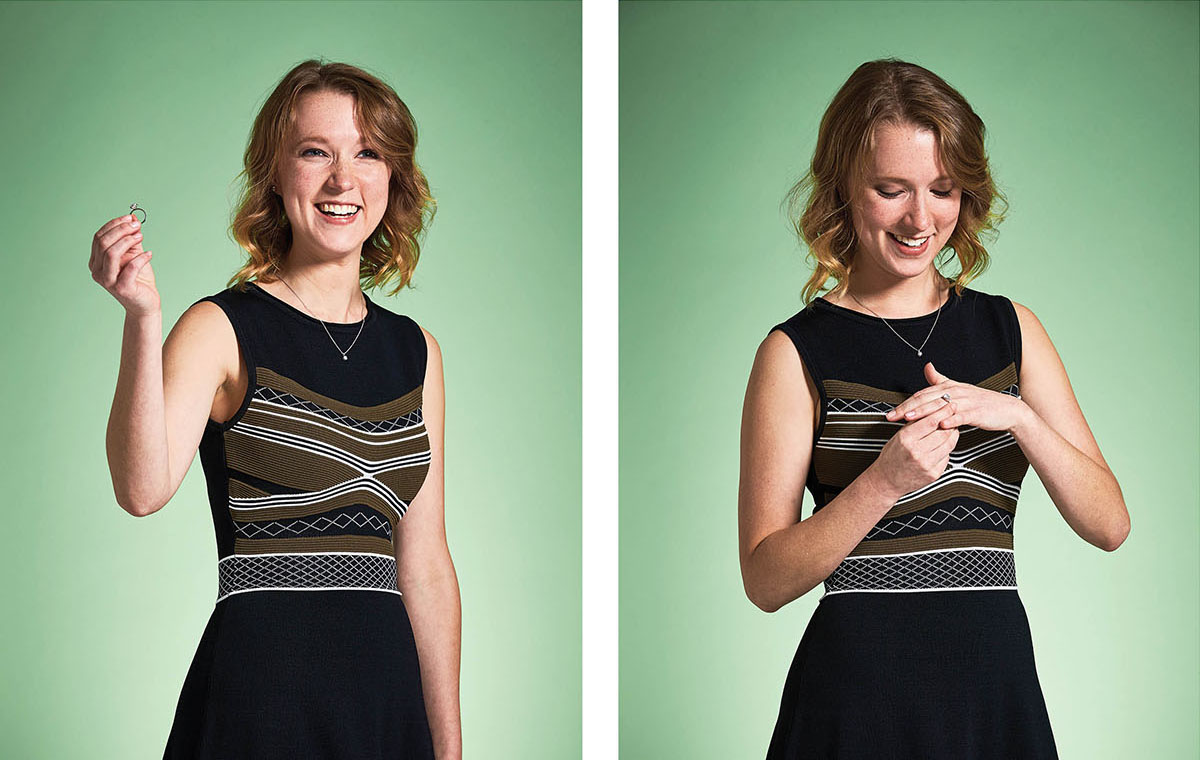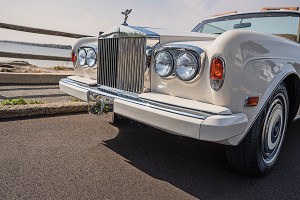The Ring Leader: Audrey Brooks of Brilliant Earth

Photographs by David Salafia / Hair and makeup by Paula Voisembert/Team
It finally happened. You found the one. Now all you need is the perfect ring to seal the deal (no pressure!). As assistant manager at Brilliant Earth, a Newbury Street jeweler dedicated to ethical, conflict-free diamond sourcing, Audrey Brooks often advises clients on the hunt for their dream engagement or wedding bling. Her advice? Have fun. “There’s no reason to feel stressed out about it,” Brooks says. “The most important thing is that you’re choosing to make a really exciting and romantic commitment to somebody, and the ring should just be a fun part of that.”
When it comes to engagement rings and wedding bands, do people usually know what they want when they come in, or do they need some guidance?
I’d say maybe a third of the people that I meet with have a really strong idea coming in. A lot of people do need guidance. Sometimes they’ll know the metal type or that they definitely want a diamond. But people often come in and have no idea where to start, and that’s when we’re happy to jump in and help.
How can brides- and grooms-to-be prep for the shopping experience?
One thing that’s really helpful is to look around and see what your friends and parents are wearing and get a sense of what you like. Sometimes when I meet with the partner who will be doing the proposing, that partner will come in with the Pinterest page of their soon-to-be fiancé. We can look through that and see a good direction to go from those ideas.
Your job must be really fun. I’m sure you work with a lot of happy people.
That’s true. I really do feel like this is the best job in the world. We get to work with couples at such an exciting time in their lives.

Do customers share their proposal plans with you?
Yeah, absolutely. Proposal ideas can actually help shape the ring that a client ends up choosing: If someone is planning an outdoor proposal, sometimes the ring will have more of a nature-inspired look to it, for example. It’s so fun to be involved in that, and people constantly send us pictures of their proposals afterward. That’s probably my favorite part of the job.
Are there still rules about how much you should spend on an engagement ring, or is that antiquated now?
That rule about spending a certain amount of your paycheck on the ring is definitely out the window. The proposal is just one part of the wedding process, and there are a lot of other things to keep in mind. The timing of the proposal can affect the way you choose to prioritize your finances when it comes to picking out the ring. There’s no wrong amount—it just comes down to what’s important to you.
If you’re the recipient of a ring you don’t like, should you just suck it up and live with it?
No [laughs]. Do not live with it! I recommend that customers do their research to make sure that they have the ability to modify things after the fact. At Brilliant Earth, we have a full return or exchange policy for circumstances like that. And there’s nothing wrong with saying, “I love you. Yes, I want to spend the rest of my life with you. Can we get a different gemstone, or a different setting, or something totally different?”
What styles are popular right now?
What we’re seeing a lot of in Boston are timeless pieces, so either very classic solitaires with a plain metal band or diamond accents on the band, or vintage-inspired styles. On a more national scale, popular styles include alternative metal types—including rose gold—and unique colored gemstones. People weren’t always proposing with diamonds. In fact, sapphires were the original proposal gemstone. Traditionally, blue is the color of fidelity.
Choosing one ring to live with forever is a big commitment. Any advice on narrowing the field?
One of the sweetest ways I saw someone do it is when two women came into the showroom. They were best friends, and one was picking out a ring and couldn’t decide between two. Her friend held one ring in each fist, and then spontaneously opened one and said, “Are you happy, or would you have wanted the other one?” It gave her friend the opportunity to have that immediate reaction.
How should couples care for their new rings?
One of the most important parts of ring care is having the prongs checked. You want to make sure you’re not going to lose the center gemstone or any accent gemstones. I recommend swinging by your jeweler every six months or so just to have the prongs checked. It is fine jewelry, and an emotional and financial investment. It’s definitely something that you want to take care of.
38 Newbury St., Boston, 800-691-0952, brilliantearth.com.
Tips
Audrey Brooks breaks down the diamond’s four essential properties.
CARAT Weight This is the most immediately visible aspect of the diamond, and correlates closely with how big it appears. It can be helpful to come in with a price point in mind, and choose the appropriate carat weight within that range.
CLARITY This is the one characteristic that’s measured under magnification rather than the naked eye. Being flexible with the clarity grade allows you to prioritize things that are visible. I recommend staying in a clarity range of VF2 and above, because these diamonds don’t have obvious inclusions.
CUT Cut is the brilliance, or the sparkle, of the diamond. Diamonds that have a higher cut grade are going to have more light return and therefore more sparkle.
COLOR Color speaks to the inherent tone of the diamond. Those in the J through G range typically show warmth or neutral tones. F- through D-range diamonds are colorless and exhibit cooler or icy-white tones. Below J, you’ll notice a lot of distinctively yellow tones.
Getting married? Start and end your wedding planning journey with Boston Weddings' guide to the best wedding vendors in the city.


